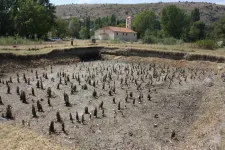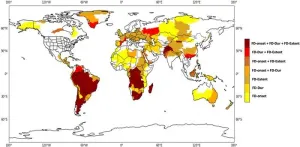(Press-News.org) Researchers at the University of Bern have for the first time been able to pin down a prehistoric settlement of early farmers in northern Greece dating back more than 7,000 years to the year. For this they combined annual growth ring measurements on wooden building elements with the sudden spike of cosmogenic radiocarbon in 5259 BC. This provides a reliable chronological reference point for many other archaeological sites in Southeast Europe.
Dating finds plays a key role in archaeology. It is always essential to find out how old a tomb, settlement or single object is. Determining the age of finds from prehistoric times has only been possible for a few decades. Two methods are used for this: dendrochronology, which enables dating on the basis of sequences of annual rings in trees, and radiocarbon dating, which can calculate the approximate age of the finds by the decay rate of the radioactive carbon isotope 14C contained in the tree rings.
A team led by the Institute of Archaeological Sciences at the University of Bern has now succeeded in precisely dating timber from the archaeological site of Dispilio in northern Greece, where dating to the year had previously not been possible, to different building activities between 5328 and 5140 BC. The researchers made use of high-energy particles from space, which can be reliably dated to 5259 BC. Their research has been published in the journal Nature Communications.
Tree-ring chronologies and the 14C method have their limits
Dendrochronology uses characteristic patterns of broad and narrow annual growth rings in wood, which are influenced by climatic conditions. As a result, a wooden object can be dated by comparing the annual growth ring widths with already existing standard or regional chronologies. “In Central Europe there is a tree-ring chronology that goes back almost 12,500 years into the past – to the year 10,375 BC. However, this chronology only applies to certain regions. There is no consistent chronology for the Mediterranean region,” says the lead author of the study, Andrej Maczkowski from the Institute of Archaeological Sciences at the University of Bern.
Therefore, dendrochronological dating from this region must be classified as ‘floating’ using radiocarbon dating. As long as a tree is alive, it absorbs the radioactive isotope 14C (radiocarbon) contained in the Earth’s atmosphere through photosynthesis. When it dies, it no longer absorbs 14C; the isotope decays with a half-life of 5730 years. A laboratory measurement method can then be used to determine how much 14C is still contained in a particular tree ring and thus calculate the tree’s approximate time of death over the known half-life. “However, the accuracy of such classifications is in the best case within the range of decades,” says Maczkowski. “Until recently, it was therefore believed that dendrochronological dating to the year was only possible if a continuous regional tree-ring chronology was available, which is the case for prehistoric periods in just three regions worldwide: this is the southwestern United States, the northern Alpine foothills and England/Ireland,” explains Albert Hafner, Professor of Prehistoric Archaeology at the University of Bern and senior author of the study.
Paradigm shift thanks to Japanese physicist
In 2012, a solution to the problem emerged: Japanese physicist Fusa Miyake discovered that a massive influx of cosmic rays, presumably due to solar flares, can cause an uptick in the atmosphere’s 14C content, which is deposited in the respective years’ tree rings. These spikes can be accurately dated on the basis of long tree-ring chronologies, and because they are global events, they are important anchor points, especially in regions without consistent annual growth ring chronologies. “Miyake recognized the first anchor points of this kind and thus brought about a paradigm shift in prehistoric archaeology,” says Albert Hafner. Today, a dozen of these Miyake events are known up until 12,350 BC, and the two important events in 5259 and 7176 BC were only discovered in 2022 by researchers at ETH Zurich. No such events of similar magnitude have been recorded in the past few centuries. If an event of this magnitude, as in 5259 BC, happens today it will likely have a disastrous effect on telecommunications and electronics.
Miyake event enables dating in Dispilio
The research team from the EXPLO project led by the University of Bern (see box) has succeeded in establishing an annual growth ring chronology spanning 303 years, which ends in 5140 BC, by analyzing 787 pieces of timber from the archaeological site of Dispilio on Lake Orestida in northern Greece. The identified settlement phases show various house building activities over 188 years between 5328 and 5140 BC. This precise dating is possible because there was a known Miyake event during this period in 5259 BC.
Researchers at ETH Zurich were able to detect a spike in radiocarbon content during this time by radiocarbon dating several individually defined annual growth rings. It was therefore a question of reproducing this peak, which is reflected globally in the annual growth ring chronologies of Siberian larch, American pine, and European oak, on the annual growth ring chronology from Dispilio in Greece and connecting it to the anchor point 5259 BC. “The Balkans is therefore the first region in the world to benefit from this paradigm shift and to be able to successfully determine absolute dating independently of a consistent calendar,” says Albert Hafner.
Andrej Maczkowski adds: “We expect that other chronologies for the region from this period can now be linked to the ‘Dispilio Chronology’ in rapid succession. This paves the way to developing a regional dendrochronology for the southern Balkans. “The Balkans have the oldest lakeside settlements in Europe, whose sites are dated to just after 6000 BC. The region played a key role in the expansion of agriculture in Europe.
END
Cosmic rays illuminate the past
2024-05-21
ELSE PRESS RELEASES FROM THIS DATE:
Ochsner Health hosts third annual Black Men’s Health Event at Zulu Social Aid and Pleasure Club on May 25
2024-05-21
NEW ORLEANS – Ochsner Health will host The Black Men’s Health Event from 10 a.m. to 2 p.m. on Saturday, May 25 at Zulu headquarters on 732 N. Broad St. This marks the third consecutive year for this free event, which emphasizes community health and wellness.
Presented by the Janssen Pharmaceutical Companies of Johnson and Johnson, along with community partner The Zulu Social Aid and Pleasure Club, The Black Men’s Health Event advances a core mission to improve healthcare access, health equity and health outcomes.
Attendees can take advantage of several free medical screenings:
Blood Pressure
Glucose
Cholesterol
Lung ...
New tool may help prioritize high-risk infants for RSV immunization
2024-05-21
EMBARGOED UNTIL: 9:39 a.m. PT, May 21, 2024
Session: C17 – Pediatric Impact of COVID-19 and Other Respiratory Infections
Clinical Prediction Tool for Prioritizing Respiratory Syncytial Virus Prevention Products for High-Risk Infants During Current Limited Availability of Nirsevimab in the United States
Date and Time: Tuesday, May 21, 2024, 9:39 a.m. PT
Location: San Diego Convention Center, Room 6D (Upper Level)
ATS 2024, San Diego – On the heels of a shortage of nirsevimab for infant respiratory syncytial virus (RSV) lower respiratory tract infection (LRTI) prevention, a new tool ...
Drug helps reprogram macrophage immune cells, suppress prostate and bladder tumor growth
2024-05-21
FOR IMMEDIATE RELEASE
A novel therapy that reprograms immune cells to promote antitumor activity helped shrink hard-to-treat prostate and bladder cancers in mice, according to research from the Johns Hopkins Kimmel Cancer Center and its Bloomberg~Kimmel Institute for Cancer Immunotherapy and Johns Hopkins Drug Discovery.
The study was published online May 3 in the journal Cancer Immunology Research, a journal of the American Association for Cancer Research.
Immunotherapies that help the immune system recognize and fight tumors have revolutionized care for many types of cancer. However, ...
Green infrastructure plans need to consider historical racial inequalities, say researchers
2024-05-21
CHAMPAIGN, Ill. — Urban planners increasingly are interested in green infrastructure projects for the health and climate benefits they bring to cities. But without attention to historical development patterns and existing power structures, such projects may not benefit all residents equally and may exacerbate social and racial inequalities, says a group of researchers and practitioners of nature-based solutions for urban areas.
The researchers outlined their recommendations for a justice-oriented approach to urban greening projects in a paper published in the journal ...
ENDO 2024 press conferences to highlight male birth control, anti-obesity medications
2024-05-21
BOSTON—Researchers will delve into emerging research in diabetes, obesity, reproductive health and other aspects of hormone health during the Endocrine Society’s ENDO 2024 news conferences June 1-4.
The Society also will share its vitamin D Clinical Practice Guideline publicly for the first time during a news conference on Monday, June 3. Reporters will have an opportunity to hear directly from members of the guideline development panel.
Other press conferences will feature select abstracts that are being presented at ENDO 2024, the Endocrine Society’s ...
Highly sensitive fiber optic gyroscope senses rotational ground motion around active volcano
2024-05-21
WASHINGTON — Researchers have built a prototype fiber optic gyroscope for high resolution, real-time monitoring of ground rotations caused by earthquakes in the active volcanic area of Campi Flegrei in Naples, Italy. A better understanding of the seismic activity in this highly populated area could improve risk assessment and might lead to improved early warning systems.
“When seismic activity occurs, the Earth’s surface experiences both linear and rotational movements,” said research team leader Saverio Avino from the Consiglio Nazionale delle Ricerche Istituto Nazionale di Ottica (CNR-INO) ...
Research reveals endurance exercise training impacts biological molecules
2024-05-21
As part of an ongoing national research effort to better understand how physical activity improves health and prevents disease, seven University of Colorado Department of Medicine faculty members contributed to an article recently published in Nature, an international journal of science.
The paper, “Temporal dynamics of the multi-omic response to endurance exercise training,” discusses how eight weeks of endurance exercise training affected male and female young adult rats. The researchers found that all bodily tissues that were tested ...
Does managing oxidative stress hold the key to effectively treating Alzheimer’s disease
2024-05-21
Amsterdam, May 21, 2024 – The number of people suffering from Alzheimer’s disease (AD) is expected to reach 100 million by 2050, but there is still no effective therapy. Leading researchers from around the world assess how oxidative stress (OS) may trigger AD and consider potential therapeutic targets and neuroprotective drugs to manage the disease in a collection of articles in a special supplement to the Journal of Alzheimer’s Disease, published by IOS Press.
AD is the most common type of dementia and involves areas of ...
Warming climate intensifies flash droughts worldwide
2024-05-21
WASHINGTON — Sudden, severe dry spells known as flash droughts are rising in intensity around the world, with a notable exception in mountainous Central Asia, where flash drought extent is shrinking, according to new research. Heat and changes to precipitation patterns caused by a warming climate are driving these trends, the study found.
Flash droughts arrive suddenly, within weeks, hitting communities that are often not prepared and causing lasting impact. They are an emerging concern for water and food security. The new study is the first to apply a systematic, quantitative approach to the global incidence of flash drought, mapping hotspots and ...
US public health preparedness and response to highly pathogenic avian influenza A(H5N1) viruses
2024-05-21
About The Study: Public health authorities in nearly all states and territories surveyed reported the ability to monitor and test persons exposed to highly pathogenic avian influenza (HPAI) A(H5N1) virus. However, jurisdictions varied in their capacity to monitor exposed persons, in recommendations for use of antivirals, and in potential use of H5N1 vaccines, if available, among first responders.
Corresponding Author: To contact the corresponding author, Noah Kojima, M.D., email nkojima@cdc.gov.
To access the embargoed study: Visit our For The Media website at this ...






